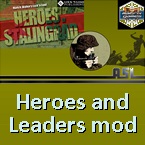asl3d
Posts: 6531
Joined: 2/6/2017
Status: offline

|
US Vehicular Pontoon
By 1943, combat engineers faced the need for bridges to bear weights of 35 tons or more. To increase weight bearing capacity, they used bigger floats to add buoyancy. This overcame the capacity limitation, but the larger floats were both more difficult to transport to the crossing site and requiring more and larger trucks in the divisional and corps trains.
A treadway bridge was a multi-section, prefabricated floating steel bridge supported by pontoons carrying two metal tracks (or "tread ways") forming a roadway. Depending on its weight class, the treadway bridge was supported either by heavy inflatable pneumatic pontons or by aluminum-alloy half-pontons. The aluminum half-pontons were 9.02 m long overall, 2.11 m wide at the gunwales, and 1.02 m deep except at the bow where the gunwale was raised. The gunwales were 2.03 m center-to-center. At 150 mm freeboard, the half-ponton has a displacement of 12,000 kg. The sides and bow of the half-ponton sloped inward, permitting two or more to be nested for transporting or storing.
A treadway bridge could be built of floating spans or fixed spans. An M2 treadway bridge was designed to carry artillery, heavy duty trucks, and medium tanks up to 37 tons. This could be of any length, and was what was used over major river obstacles such as the Rhine and Moselle. Doctrine stated that it would take 5 1/2 hours to place a 362-foot section of M2 treadway during daylight and 7 1/2 hours at night. Pergrin says that in practise 50 ft/hour of treadway construction was expected, which is a little slower than the speed specified by doctrine.
A Heavy Ponton Bridge Battalion was provided with equipage required to provide stream crossing for heavy military vehicles that could not be supported by a light ponton bridge. The Battalion had two lettered companies of two bridge platoons each. Each platoon was equipped with one unit of heavy ponton equipage. The battalion was an organic unit of army and higher echelons. The M1940 could carry up to 23 tons. The M1 Treadway Bridge could support up to 18 tons. The roadway, made of steel, could carry up to 45 tons, while the center section made of 100 mm thick plywood could carry up to 27 tons. The wider, heavier tanks used the outside steel treadway while the narrower, lighter jeeps and trucks drove across the bridge with one wheel in the steel treadway and the other on the plywood.
An Engineer Treadway Bridge Company consisted of company headquarters and two bridge platoons. It was an organic unit of the armored force, and normally was attached to an Armored Engineer Battalion. Each bridge platoon transported one unit of steel treadway bridge equipage for construction of ferries and bridges in river-crossing operations of the armored division. Stream-crossing equipment included utility powerboats, pneumatic floats, and two units of steel treadway bridge equipment, each of which allowed the engineers to build a floating bridge about 160 m in length.

 Attachment (1) Attachment (1)
< Message edited by asl3d -- 1/26/2021 6:24:10 PM >
_____________________________
Semper fidelis
|
 Printable Version
Printable Version





































 New Messages
New Messages No New Messages
No New Messages Hot Topic w/ New Messages
Hot Topic w/ New Messages Hot Topic w/o New Messages
Hot Topic w/o New Messages Locked w/ New Messages
Locked w/ New Messages Locked w/o New Messages
Locked w/o New Messages Post New Thread
Post New Thread